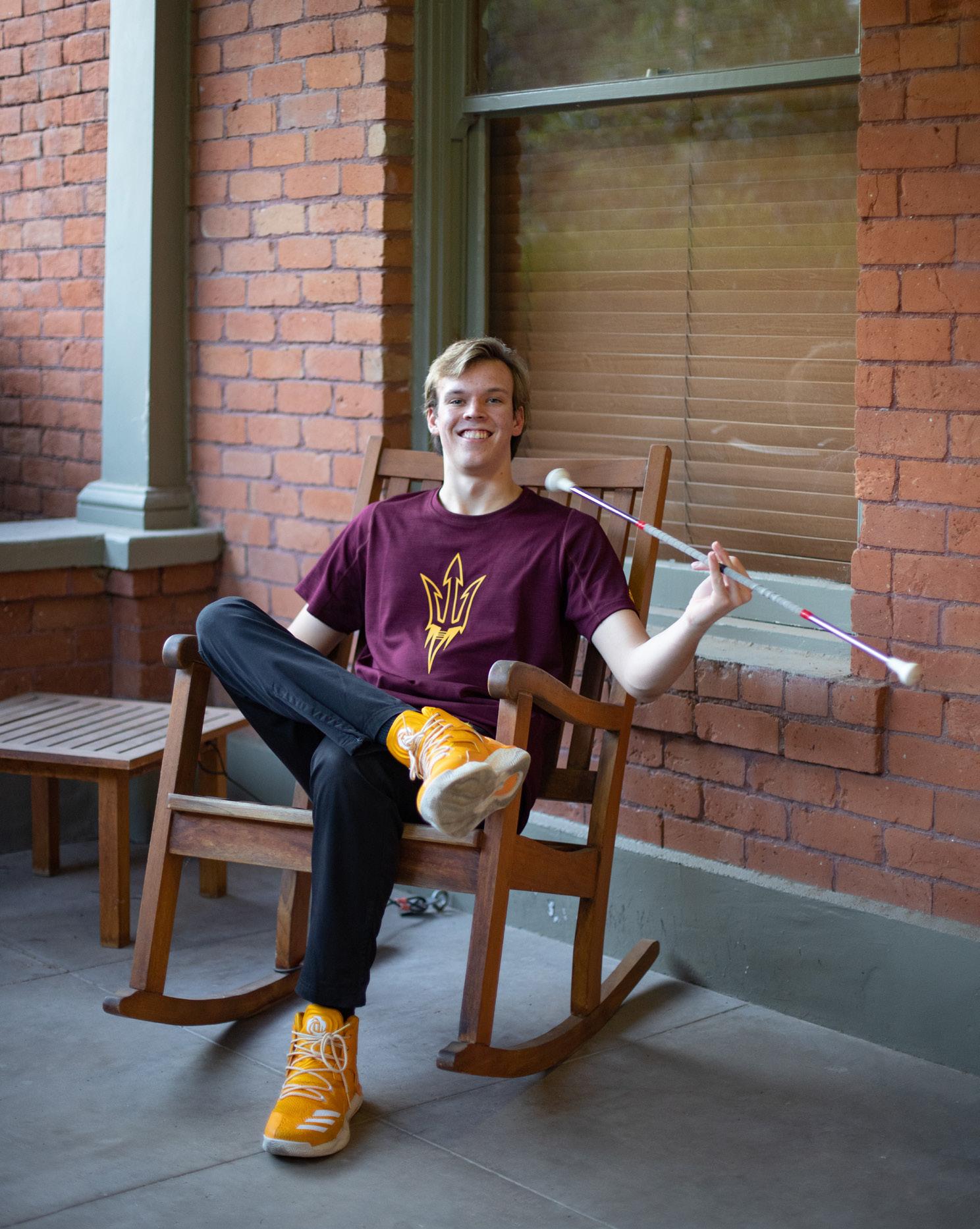
8 minute read
Cody Carter: One of the last true great American twirlers
From silverware to batons, ASU twirler details his upbringing and plans for the future
by Ike Everard Photography by Matt Keough
Far away from the bright lights and roaring fans in Sun Devil Stadium, world champion baton twirler Cody Carter steps into Esporta Fitness.
Tucked behind ellipticals and rowing machines, a glass doorway opens into a repurposed basketball court. The floor is covered in exercise bikes and yoga mats, and the rims have been removed. That doesn’t stop Carter.
The space is cool, and windows lining the upper part of each wall let in sunlight. It’s his own little sanctuary. A place away from the masses to work out to pop songs played over tinny speakers.
“I don’t have it reserved or anything,” Carter said with a grin. “I’ve seen like 10 people here ever. I don’t know if they don’t know about it or what.”
It’s not an ideal space, as Carter throws a baton 300 feet in the air during his outdoor routines. The low ceilings get in the way, and Carter jokes he could “take the roof off the place” if he wanted to.
On the way out the door, he’s stopped by a gym worker. “It’s always twirling with you,” the manager said with a smile. “I’ve known him since he was little.”
Carter laughs and gives the worker a fist bump.
“I’m friends with everybody here,” Carter said, smiling and waving to another worker on the way out.
Carter’s first experience with twirling took place just behind that very gym, at Stonecreek Golf Club where his parents work as instructors.
“I would be teaching chipping class to the younger children,” Debbie Carter, Cody’s mom, said. “And Cody was standing over there twirling his seven iron instead of hitting golf balls with it.”
Debbie Carter, a casual twirler during her own youth, realized what her son needed. She got him a baton and at the suggestion of one of her golf student's parents, a coach.
“We thought, ‘OK, it’ll be one lesson, it’ll be one and done,’” Cody’s dad, Jack Carter, said. “The rest is history.”
After that first brush with the sport, twirling became ingrained in Carter’s mind. He’d twirl anything he could find around the house, from drumsticks to pencils. Any time the family went out to dinner, there sat Carter, twirling silverware in the restaurant.
“He would be working on homework,” Debbie Carter said, “and he’d be like, ‘Mom, I have to go twirl.’ I’d say, ‘OK, go ahead, do it for a little while.’ I knew it was something he needed to do.”
A legend takes notice
Jerry Alvarez, world-renowned twirling coach, saw Carter for the first time at a competition after one of his students told him to stay and watch. Sitting in the audience, Alvarez was sold.
“I could tell by his general handling, I said, ‘This boy has a lot of talent, he just doesn’t have the coaching,’” Alvarez said.
Alvarez identified Carter as someone he wanted to work with when Carter was only seven years old. The Carters would drive to Alvarez’s studio in Palm Springs twice a month, and while they started with the basics, Carter quickly pushed to move into more advanced maneuvers.
“He picked it up really fast, and I thought, ‘Man, this kid, he’s gonna be good,’” Alvarez said. “I said, ‘Did you work on the routine?’ and he said, ‘Yeah, but it’s really easy.’”
At one point early in his training with Alvarez, Carter learned how to do a single spin. When he came back for his next lesson two weeks later, he had taught himself how to do a double.
“My God, that's amazing that he tries these things on his own,” Alvarez said.
Time in the limelight
It was a standard day at the Carter home in December 2015 until Carter’s brother brought home a flyer advertising auditions for America’s Got Talent in downtown Phoenix. Carter was eager to go and show the judges his talents.
“We saw on the news that they said, ‘If you get here by midnight, we’ll see you,’” Debbie Carter said. “After work, we headed to downtown Phoenix, very late at night.”
The judges liked what they saw, and sure enough, Carter was on to the big show. His debut aired on July 5, 2016, with Carter receiving yes votes from all four judges. His performance sent him to the next round, where he was eliminated after performing a routine with flaming batons. For Carter, the experience was about much more than winning or losing.
“To be able to take baton twirling to the biggest stage in America and share it with the world was awesome,” Carter
said. “You’re in the room with these people that are crazy talented, and to be able to be with them and hear their stories, there’s nothing like it.”
Alvarez himself began twirling at a similarly young age. He was seven years old and already boasting a decorated career. In his eyes, however, the sport is dying and Carter is one of the last true great American twirlers.
“Baton is kind of fading away,” Alvarez said. “You’re not going to see twirlers like him.”
Carter brings originality in spades. After drawing Alvarez out of retirement, Carter developed a unique hip-hop based style, astounding onlookers. His use of rhythmic and modern moves revitalizes the originality Alvarez so desperately longed to see in twirling.
The shoes are an eccentricity of the sport. Carter prefers Jordans, as their strong toe provides a good base to spin on as he performs various maneuvers. ASU, however, is an Adidas school. The shoes provided are mesh based, thus Carter was given a special pair.
In competitions, he wears Jazz shoes.
“For him to recognize that he needs to be different and then to come up with this whole unique thing is interesting because the sport is so traditional. For him to come in from this different angle is refreshing,” Jack Carter said. “Especially at the world stage, they’re looking forward to seeing what he’s going to bring to the floor.”
“Most students have ballet training, but he didn’t,” Alvarez said. “But his movement was very good. He said, ‘I don’t like that style because it’s what everybody does. I want to do hip-hop.’”
That decision, and the development that followed, led Carter on a path to success that rivals twirling greats like Stacy Singer and Annetta Lucero. He’s won three gold medals at the WFNBTA
world championships, along with a number of regional and national championships.
“I won my first world championship gold medal in Italy when I was 13 years old,” Carter said. “It felt incredible. It was just all these years of hard work, dedication and perseverance all paid off in that moment.”
On the field
It’s 4:00 p.m. on a Saturday evening in October. The Sun Devil football team is set to take on Oregon at 7:00 p.m. For Carter, this is his moment, too. He gets ready with the band, and as they begin the walk from Desert Financial Arena to the football stadium, he’s not nervous.
“There’s nothing like the feeling when you run out of the Tillman Tunnel,” Carter said. “I just get locked in. I’ve practiced so much that it’s like tunnel vision.”
Growing up a Sun Devil fan, Carter felt like the decision to attend ASU was almost fate. While he had offers from other schools, he never felt more comfortable than when adorned in maroon and gold.
“It was like a dream come true,” Jack Carter said.
“Plus, we get to go to the games,” Debbie Carter added with a laugh.
Carter can be seen before every ASU home game twirling in the south endzone, directly in front of the student section. It’s something students have come to expect. The cheers echo behind his every move, growing with each successful maneuver. By the time

he reaches his finale, the roars reach a fever pitch.
“It’s this huge amount of energy. It’s so cool to be able to take their energy and reciprocate it back to them in my twirling,” Carter said. “Just to be able to pump everyone up for the game is an incredible feeling.”
A dedicated endeavor
Those moments, performing in front of 70,000 people at Sun Devil Stadium, receiving a gold medal on a world podium, are only made possible by Carter’s dedication to practice. His mother and coach have both tried to tell him spending upwards of six hours a day in the gym is unnecessary, but he disagrees.
When the gym was closed during the height of the pandemic, Alvarez was worried Carter would get heatstroke practicing outside. In that back room next to the golf course, he practices six to eight hours a day.
For Carter, twirling isn’t about the accolades or the attention. It’s simply something he needs to do.
“We never pushed him to practice, never pushed him to go to lessons,” Debbie Carter said. “There’s times when he got older and I was like, ‘You just need to relax, you’re working too hard.’ But you never can stop him.”
While Alvarez believes men’s twirling is beginning to fade, there are some who believe Carter could be the resurgence it needs. Coaches from around the world ask Alvarez about the unique moves he

“For him to recognize that he needs to be different and then to come up with this whole unique thing is interesting because the sport is so traditional. For him to come in from this different angle is refreshing, especially at the world stage, they’re looking forward to seeing what he’s going to bring to the floor.” — Jack Carter

develops and performs, and Carter has even started to spread his knowledge through teaching other young twirlers around the country.
Carter wants to end up in Cirque du Soleil after college, following in the footsteps of Alvarez’s former student and multi-champion twirler Annetta Lucero. For him, it would be an opportunity to share the sport he deeply loves with a wider audience. For so many others in the field, it would provide a much-needed boost in their efforts to revitalize what some see as a lost American passion.
“All he wants to do is entertain and inspire people,” Debbie Carter said. “It’s his dream come true, which makes it our dream come true.”







